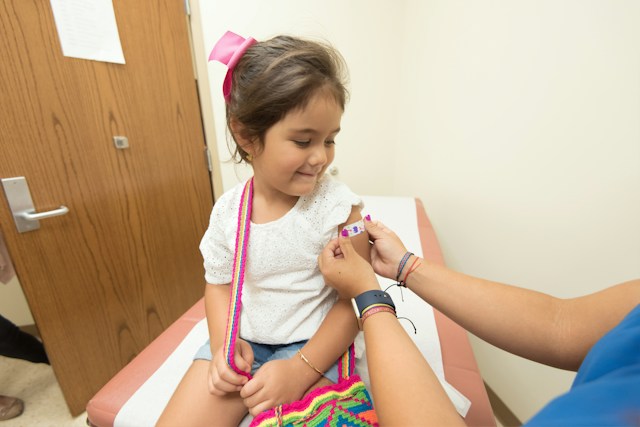Parents and other carers must be aware of the most frequent illnesses that affect children since they are vulnerable to a variety of ailments. We’ll explore the top ten kid ailments in this blog, giving you the information you need to protect the health of your small ones.

Most Common Conditions Among Children
Typical Cold:
One of the most frequent paediatric infections is the common cold, which is mostly brought on by rhinoviruses. Sneezing, coughing, runny or stuffy nose, and occasionally a low-grade fever are the symptoms. The virus is extremely infectious because it spreads through respiratory droplets. The common cold can be difficult for young children as they may feel uncomfortable and have trouble sleeping, even though it is often a minor and self-limiting disease. The common cold is treated with rest, fluids, and over-the-counter drugs to reduce symptoms; but, as the common cold is viral in origin, antibiotics are useless.

Infections of the ears:
A common paediatric illness called otitis media is characterised by middle ear inflammation. When germs or viruses go into the ear, it frequently happens after a cold or respiratory illness. Because of their smaller and more horizontal Eustachian tubes, children are more likely to have ear infections. The symptoms include hearing loss, ear discomfort, and occasionally fever. Antibiotics for bacterial infections, pain management, and in certain situations, the placement of ear tubes to aid with drainage, may all be part of the treatment. In order to treat underlying concerns, a medical assessment may be necessary for persistent or recurring ear infections.
Strep Throat:
Streptococcus pyogenes is the bacteria that causes streptococcal throat infection, sometimes referred to as strep throat. A painful throat, trouble swallowing, fever, and occasionally a red rash are its hallmarks. Respiratory droplets are how strep throat spreads, making it extremely infectious. Antibiotic therapy must begin as soon as possible in order to avoid problems like rheumatic fever. Getting enough sleep, staying hydrated, and using throat lozenges might also aid with symptom relief.

Gastroenteritis:
Also known as the stomach flu, gastroenteritis is an inflammation of the intestines and stomach that is typically brought on by viral infections like norovirus or rotavirus. Frequent symptoms include fever, vomiting, diarrhoea, and stomach discomfort. Rehydrating the patient is part of the treatment to avoid dehydration, as the sickness usually resolves on its own. In extreme situations, medical care can be required, particularly if symptoms worsen or there are indicators of dehydration.
Varicella, or chicken pox:
The varicella-zoster virus is an extremely infectious virus that causes chickenpox. It manifests as an itchy rash that develops into blisters filled with fluid. Fever and a general malaise are possible additional symptoms. Although the frequency of chickenpox has decreased dramatically due to vaccination, cases sometimes arise. Taking antihistamines for itchy sensations and practising proper hygiene to avoid additional bacterial infections are the two major forms of treatment.
Disease of the Hand, Foot, and Mouth:
A frequent cause of Hand, Foot, and Mouth Disease (HFMD) is the Coxsackievirus. It usually affects young children and is characterised by mouth, hand, and foot sores or blisters. Contact with body fluids that are contaminated can spread the infectious disease HFMD. Even though the illness is usually benign and self-limiting, supportive care is crucial, including pain management and staying hydrated.
Bronchiolitis:
A lower respiratory tract illness that frequently affects newborns and early children is called bronchiolitis. The respiratory syncytial virus (RSV) is frequently the reason. Coughing, wheezing, fast breathing, and breathing difficulties are among the symptoms. While oxygen therapy may be necessary in hospitals for severe instances, supportive care at home may be enough in milder cases.
Croup:
A viral illness known as croup affects the upper respiratory tract, resulting in tracheal and bronchial swelling and constriction. Hoarseness, respiratory discomfort, and a barking cough are its defining characteristics. Young children are most commonly affected by croup, which is typically brought on by the parainfluenza virus. Severe instances may need medical attention, while mild cases can be treated at home with humidified air and water.
UTIs, or urinary tract infections:
Children can have UTIs, which are frequently brought on by bacteria getting into the urinary system. Abdominal discomfort, frequent urination, and pain or burning during urine are possible symptoms. In order to stop an infection from spreading to the kidneys, immediate medical attention and antibiotic therapy are necessary.
Rosacea conjunctivitis:
The thin membrane that covers the white portion of the eye, the conjunctiva, becomes inflamed when someone has conjunctivitis. Allergies, germs, or viruses might be the reason. Itching, drainage, and redness are some of the symptoms. While bacterial conjunctivitis may require antibiotic eye drops, viral conjunctivitis is very infectious and usually goes away on its own. Antihistamine eye drops and avoiding allergens are the two main ways to treat allergic conjunctivitis.
In summary:
As we commemorate Children’s Day, let us give the health and welfare of the young people in our community first priority. Preventing and treating common paediatric diseases is mostly dependent on raising awareness and taking preventive steps. We can make sure that our kids continue to flourish by keeping ourselves educated and creating a healthy atmosphere.
You may also like:
How to Limit Screen Time & Boost Your Child’s Mental Health
Protecting Our Future: How to Help Children Cope with Trauma

